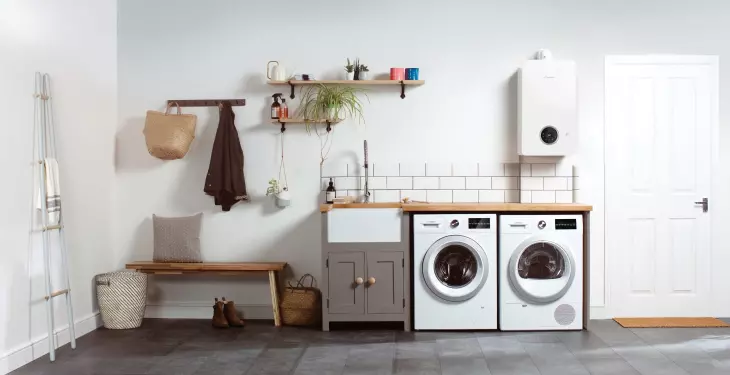

Written by Stephen Day
Gas Safe Engineer
Updated: 30th May, 2025
Connecting a wood burner to your central heating system can be an efficient way to heat your home. It can also reduce reliance on gas or electric boilers.
Get a new boiler quote, save up to £550 per year (0% APR available).
Linking a wood burner to a central heating system can be a wise choice for those looking to enhance their home's heating efficiency. By integrating a wood burner with your central heating, you can enjoy both the cosy ambiance of a fire and the benefits of an efficient heating system. This process can seem daunting at first, but with the right guidance, it's an achievable task for many homeowners.
In 2025, the rules regarding wood burners in the UK are evolving. It’s important to stay informed about these changes to ensure compliance and maximise efficiency. Many homeowners are also turning to biomass boilers as an environmentally friendly alternative, offering a sustainable option for home heating.
Get a quote in 60 seconds, fitted as fast as next day!
0% APR finance available.
A wood burner, commonly known as a wood-burning stove, is a heating appliance that uses wood fuel. It is often made of cast iron or steel and includes a firebox where the wood burns. The design allows for the efficient transfer of heat to the surrounding area.
Key Features:
Firebox: This is where the wood burns. It's designed to handle high temperatures.
Flue: A pipe that directs smoke and fumes outside.
Glass Door: Allows you to view the flames while keeping the fire contained.
Wood burners are popular for their ability to heat a room quickly. They are available in various sizes and designs to suit different spaces and preferences. Some models also have a cooking surface on top, adding functionality.
The efficiency of a wood-burning stove can reach up to 80%, making it an economical choice for household heating. New models come with enhanced features to reduce emissions, adhering to stricter regulations.
Using a wood-burning stove requires careful placement. It must be positioned on a non-combustible surface and have adequate clearance from flammable materials to ensure safety.
These stoves not only provide warmth but also add a cosy atmosphere to the home. With proper use, a wood stove can be a sustainable way to heat your living space.
Wood burning stoves have become a popular choice for many households. They provide an efficient and reliable way to heat a home.
Logs and Kiln-Dried Firewood
Using logs as fuel can be cost-effective. Kiln-dried firewood is especially efficient, providing more heat and burning cleaner than other options. This type of wood helps in reducing emissions while maintaining a warm temperature.
Environmentally Friendly
Burning dry wood results in less smoke and soot. This makes wood stoves a more environmentally friendly option compared to other fuels.
Aesthetic and Ambiance
Wood burning stoves add a cosy feel to a room. The sight and sound of crackling logs offer a comforting atmosphere.
Versatility and Independence
A wood stove can function as a backup heating source during power outages. This is useful in areas prone to electricity cuts.
Heating Efficiency
Modern wood-burning stoves are designed to maximise heat output. Users can efficiently warm multiple rooms, and when linked to a central heating system, they contribute to overall heating needs.
In summary, wood burning stoves offer various benefits, including cost savings, environmental advantages, and a unique ambiance.
Connecting a wood burner to your central heating system can be an efficient way to heat your home. It can also reduce reliance on gas or electric boilers. This guide covers the basic steps and considerations involved. Make sure to consult a professional to ensure safety and compliance with regulations.
Step 1: Choosing the Right Wood Burner
Select a wood burner with adequate heat output for your home. Check the kilowatt rating to ensure it can handle the size of your space. Look for models with a boiler feature, as these can connect directly to your central heating.
Step 2: Integration with Existing System
Linking the wood burner requires connecting it to the existing boiler system. This can be done using a method called a "SystemZone" or a thermal store. Both options allow the wood burner and your current heating system to work together efficiently.
Step 3: Installing an Air Vent
Proper ventilation is crucial. Install an air vent to ensure safe operation and efficient burning. This prevents the build-up of fumes and maintains air quality indoors.
Key Considerations
Professional Installation: Always hire a certified installer to connect the wood burner.
Safety Standards: Ensure compliance with UK safety regulations and building codes.
Compatibility: Verify that your existing central heating system is compatible with a wood-burning boiler stove.
Benefits
Efficiency: Reduces energy bills by using renewable wood fuel.
Eco-friendly: Lower carbon footprint compared to fossil fuels.
Linking a wood burner to central heating offers a sustainable heating solution. By following these simple steps, homeowners can enjoy a warm and energy-efficient environment.
A wood burner can be an efficient way to heat hot water in a home. This is usually done by integrating a wood-burning stove with a back boiler into the central heating system. It's a popular choice for those looking to reduce energy costs.
Benefits
Energy Efficiency: Wood burners can be an eco-friendly option, as they use renewable energy.
Cost Savings: Over time, they may lower heating bills due to reduced reliance on gas or electric heating.
Setup
To heat water, the wood burner needs to be connected to the home's existing heating system. This connection is commonly made via a back boiler, which transfers heat from the fire to the water.
Compatibility
Not every wood burner is suitable for this purpose. Homeowners need to ensure that their wood burner is compatible with a back boiler setup.
Considerations
Professional Installation: Hiring a professional is crucial to avoid safety risks.
Plumbing and Pipework: The system may require additional plumbing, including insulated pipes.
Vertical Orientation: Ensure pipework is installed correctly, often going vertically as close to the stove as possible.
Including a wood burner in a heating system can be a smart choice. It often involves some initial investment and planning, but many find the potential long-term savings and environmental benefits to be worthwhile.
A biomass boiler is a heating system that uses organic materials as fuel to generate heat for homes and businesses. These systems burn materials like wood pellets, wood chips, and other plant matter.
How It Works:
The boiler burns this material to heat water, which is then circulated through radiators and taps for central heating and hot water.
Biomass boilers can be an eco-friendly option. They have lower carbon emissions compared to traditional gas or oil boilers because the materials used are renewable.
Types of Fuel:
Wood Pellets: Made from compressed sawdust.
Wood Chips: Chopped pieces of wood.
Bioethanol: A type of alcohol made by fermenting sugar and starch components of plants.
Some biomass boilers need a dedicated space for storage of the biomass fuel. This can take up more space compared to fuel storage for conventional systems.
Biomass boilers may require more maintenance, as regular cleaning is needed to ensure efficient operation. They also come with initial setup costs that can be higher than gas or oil boilers.
Despite the costs and maintenance, biomass boilers offer an alternative that supports sustainability. Using renewable resources helps reduce the reliance on fossil fuels, making them a viable choice for lowering one's carbon footprint.
A biomass boiler uses organic materials such as wood logs, chips, or pellets to produce heat. When the biomass is burned, it generates energy that can heat water for central heating and domestic use.
Combustion Process:
Fuel Supply: The biomass, such as wood pellets, is fed into the boiler.
Ignition and Burning: A mechanism ignites the biomass, and the material burns in a combustion chamber.
Heat Exchange: The heat produced is transferred to a heat exchanger, warming water stored in a water cylinder.
Biomass boilers typically include automated controls to regulate the amount of fuel fed into the burner. This automation ensures the boiler operates efficiently.
Environmental Aspect:
Biomass is a renewable energy source. It reduces carbon emissions compared to traditional fossil fuels, making it an eco-friendly option.
User-Friendly Features:
Automated Fuel Feed: The system often includes a hopper or feed screw to supply fuel automatically.
Ash Collection: These boilers have ash containers to collect waste, which needs regular emptying to maintain efficiency.
Maintenance Needed:
Regular maintenance ensures optimal performance. This includes cleaning to prevent blockages and checking parts such as fans and vents.
Biomass boilers offer an eco-friendly way to heat homes. They use organic materials, like wood pellets or logs, to produce heat.
Prices vary based on several factors. Manually-fed options are often less expensive, ranging from £4,000 to £10,000. These require regular input from the user to keep running efficiently.
Automated pellet boilers cost more. A typical unit can range from £11,500 to £15,000. These come with features that automatically feed fuel into the boiler, requiring less manual intervention.
Both types require installation, which adds to the cost. Installation can range from £500 to £1,500, depending on the setup complexity.
Here's a quick summary of costs:
Biomass Boiler Type | Price Range |
Manually-fed boiler | £4,000 - £10,000 |
Automated pellet boiler | £11,500 - £15,000 |
Installation | £500 - £1,500 |
When considering a biomass boiler, think about initial costs and the long-term savings on fuel. Energy efficiency, available space, and maintenance are also key factors in decision-making.
Burning wood is often seen as a more natural way to heat a home compared to other fuels. When done correctly, it can be sustainable. Wood is considered a renewable resource because trees can be replanted and grown again.
Yet, burning wood can release carbon emissions. This can potentially harm both human health and the environment. For every unit of heat, burning wood generally emits more carbon than some other fuels like oil.
In the UK, regulations since 2022 require new wood burners to meet EcoDesign standards. These stoves produce less pollution, making them a more eco-friendly choice compared to older models.
Smokeless fuels offer another alternative. These fuels produce fewer emissions, which helps in reducing air pollution. They are often used in areas where air quality regulations are strict.
Pros of Burning Wood:
Renewable resource
Natural heating option
Cons of Burning Wood:
Higher emissions compared to some fuels
Potential impact on air quality
Choosing the right wood burner and adhering to new regulations can make burning wood more environmentally friendly. Informed choices about fuel types and burner models are crucial for reducing emissions and promoting cleaner air.
Get a quote in 60 seconds, fitted as fast as next day!
0% APR finance available.
Last updated: 30th May, 2025

Written by Stephen Day
Gas Safe Engineer at iHeat
Stephen Day is a Gas Safe registered and FGAS certified engineer with over 20 years of hands-on experience in the heating, cooling, and renewable energy industry, specialising in boiler installations, air conditioning, and heat pump systems.
LinkedInArticles by Stephen Day are reviewed by iHeat’s technical team to ensure accuracy and reliability.

19th December, 2025
The best budget boilers are Ideal, Alpha, Baxi, Worcester Bosch and Vaillant models, compa...
 Read Article
Read Article

19th December, 2025
The most reliable boiler brands in the UK: Worcester Bosch, Vaillant, Ideal, Viessmann, an...
 Read Article
Read Article

19th December, 2025
An airing cupboard is a heated storage space that uses warmth from a hot water cylinder or...
 Read Article
Read Article
No obligation. Takes less than 60 seconds.